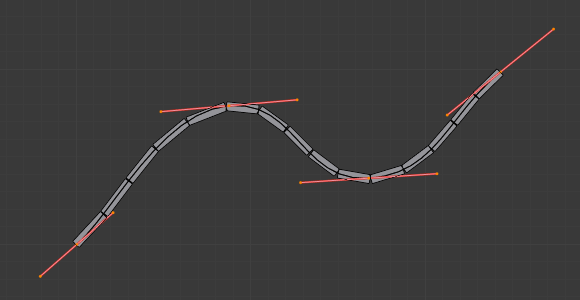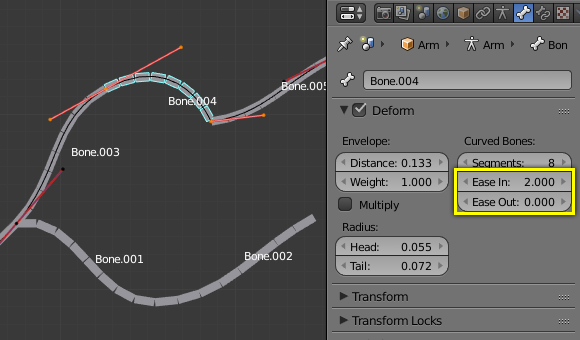Ossos maleáveis¶
Reference
| Mode: | All Modes |
|---|---|
| Panel: |
Bendy Bones (B-Bones) are an easy way to replace long chains of many small rigid bones. A common use case for curved bones is to model spine columns or facial bones.
Detalhes técnicos¶
Blender treats the bone as a section of a Bézier curve passing through the bones” joints. Each Segments will bend and roll them to follow this invisible curve representing a tessellated point of the Bézier curve. The control points at each end of the curve are the endpoints of the bone. The shape of the B-Bones can be controlled using a series of properties or indirectly through the neighboring bones (i.e. first child and parent). The properties construct handles on either end of the bone to control the curvature.
Durante as utilizações dos ossos maleáveis como um alvo de restrição, o Identificador de dados fornecerá uma opção para seguir a curvatura ao invés do meão direto entre a cabeça e a base.
Nota
However, if the bone is used as a target rather than to deform geometry, the roll is not taken in account.
Modo de visualização¶
Você somente poderá ver estes segmentos, caso os ossos sejam visualizados como ossos Maleáveis.
When not visualized as B-Bones, bones are always shown as rigid sticks, even though the bone segments are still present and effective. This means that even in e.g. Octahedron visualization, if some bones in a chain have several segments, they will nonetheless smoothly deform their geometry…
Pose de descanso¶
O formato inicial de um osso maleável pode ser definido no Modo de edição como uma pose de descanso desse osso. Isto é útil para as funcionalidades de animações faciais curvilíneas como as regiões da boca ou sobrancelhas.
Os ossos maleáveis possuem dois conjuntos de propriedades para que o usuário os controle – um para o Modo de edição (ou seja, para a base dos arranjos de animação e pose de descanso), e um outro exclusivo para o Modo de pose – para a adição de valores em conjunto para obtenção das transformações finais.
Exemplo¶
na imagem A funcionalidade antiga dos ossos maleáveis (B-Bones) no Modo de edição. A ser feito. nós conectamos três ossos, cada um deles composto de cinco segmentos.
Observando na imagem A mesma armação de ossos no Modo de edição., nós podemos ver como os segmentos dos ossos são «mesclados» entre si de maneira suave, mesmo para a rolagem.

Uma armação de ossos no Modo de pose, em visualização de ossos tipo Maleável, o osso nomeado «Bone.003» possui um segmento, o osso nomeado «Bone.004» possui quatro, e o osso nomeado «Bone.005» possui dezesseis.
Opções¶
Segmentos¶
O botão de número de Segmentos permite que você defina o número de segmentos nos quais o osso será subdividido. Os segmentos são ossos pequenos e rígidos interligados que são interpolados entre a base e a cabeça dos ossos. Quanto maior esta definição, mais suavizado o osso será, poise será mais «maleável» e mais «conformante», mas mais pesadas serão as calculações das poses.
Deslocamentos de curva em X e Y¶
Applies an offsets the curve handle positions on the plane perpendicular to the bone’s primary (Y) axis. As a result, the handle moves per axis (XY) further from its original location, causing the curve to bend.
Rolagem¶
- Rolar para dentro ou para fora
- The roll value (or twisting around the main Y axis of the bone) is interpolated per segment, between the start and end roll values. It is applied as a rotational offsets on top of the previous rotation.
- Herdar rolagem das terminações
- ToDo ~2.78.
Escala¶
- Escalonar reduzindo ou ampliando
- Scaling factor that adjusts the thickness of each segment for X and Z axes only, i.e. length is not affected. Similar to Roll it is interpolated per segment.
Facilitação¶
- Aplicação de mais ou menos facilitações
The Ease In/Out number buttons, change the «length» of the «auto» Bézier handle to control the «root handle» and «tip handle» of the bone, respectively.
These values are proportional to the default length, which of course automatically varies depending on bone length, angle with the reference handle, and so on.
Referência de hastes personalizadas¶
B-Bones can use custom bones as their reference bone handles, instead of only using the parent/child bones. To do so, enable the Use Custom Reference Handles toggle in Pose Mode. If none are specified, then the BBone will only use the Bendy Bone properties. When the option is on, just use the specified bones instead of using trying looking at the bone’s neighbors.
- Relativo(a)
- Instead of using the endpoints of the bones as absolute points in 3D space it computes how far the reference bone has moved away from its rest pose. The delta transformation is then applied as to the bone’s own endpoints to get the handle locations. This is useful if the custom control bone is far away from its target.
Dica
Conjunto de inserção de chaves
The «BBone Shape» Keying Set includes all Bendy Bones properties.
Exemplo¶

Visualization of the Bendy Bones properties.




